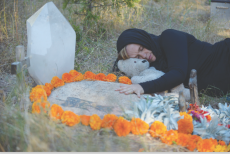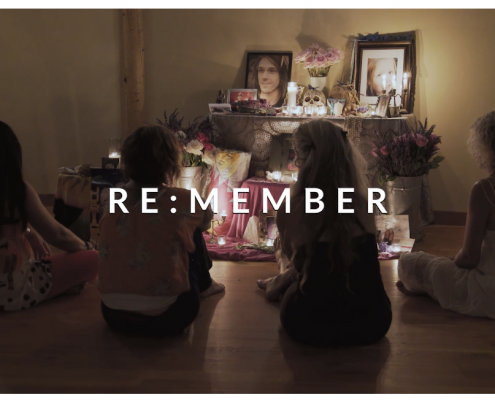Victoria Markham – A Conversation About Grief
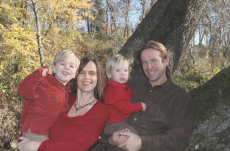 In today’s interview I speak with long term Ashland resident Victoria Markham. Victoria lost her son Koa Nakai Markham six years ago. Many in our community watched as their entire family grieved. We wondered what we could do to help, yet we often found ourselves simply unaware. What should we say? How we should behave? What are they really experiencing and what is the process? Today I will speak to Victoria about some of these questions. I will explore and look deeper into the role grief and bereavement play in our society. We will talk about death and lay down new paths for supporting one another in our town, community, and around the world.
In today’s interview I speak with long term Ashland resident Victoria Markham. Victoria lost her son Koa Nakai Markham six years ago. Many in our community watched as their entire family grieved. We wondered what we could do to help, yet we often found ourselves simply unaware. What should we say? How we should behave? What are they really experiencing and what is the process? Today I will speak to Victoria about some of these questions. I will explore and look deeper into the role grief and bereavement play in our society. We will talk about death and lay down new paths for supporting one another in our town, community, and around the world.
Victoria, thank you very much for doing this interview with me today and welcome. Tell me why you are stepping forward to do this interview.
It is imperative that we begin a new conversation about how we grieve.
Six years ago you lost your son, Koa Nakai. It was sudden, unexpected, and devastating. Many people in Ashland were immediately aware of what happened and it sent a shock wave into our community. We saw your entire family and knew what happened… but did not know necessarily what to do.
I think of the community and what that must have been like for those around us to hear of Koa’s death. We are a very safe, loving, blessed family. It really seemed to rivet people that a thing like death could find its way into an insulated family full of love and into a community that has created such safe places for kids to be raised. Nobody knew what to do. Not even us.
We loved our boy every day of his life and we did everything we could to insure safety and longevity, yet he died. I think everyone was really faced with the fact that in spite of our efforts in this life to protect our children that they can still die.
Would you care to share with us how Koa died?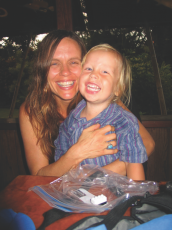
Koa died in my arms at age 3 1/2. One moment he was playing in the yard with his brother and in the next moment he was dead. I was driving down the driveway to return home and Koa ran behind my car when I pulled into my parking spot. Koa’s 7 year-old brother witnessed his brother’s passing. In two seconds flat both of my boys were changed forever. My nice safe little life with five acres and a dream turned into one child gone and one child who would now live the rest of his life without his brother.
Along the way many hands reached forward to help you after the loss of Koa. How did you find ways to let the community in to help you and your family?
I immediately asked that a structure get put up in our yard with beautifully covered tables and photos of Koa so that anyone in the community could come day or night and to the tables and spend as much time as they needed to experience their own grief. I just made it part of my seemingly endless and empty days to sit in the window and watch them all come and go. After they left I would walk outside to the altars and see what they left and just cry for them, for me, for Koa.
My more intimate community came with meals, cleaned our house, and took my older boy Banyan, (7 years old at the time), on outings to give him a break from the heaviness of life at home. I reached out to many women from the community to gather and do ceremony and just help me surrender in to the grief.
Your family chose a very intimate way to bury your child. Can you tell us a little about why and what led you to these methods?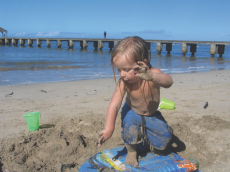
I was shocked to learn that I could be the one to prepare my son for burial and that I was allowed to bring him home from the mortuary. I took a few thousand deep breaths while preparing a basket filled with a hairbrush, oils, his favorite blanket and other objects that would honor him.
Upon arrival, I was led into the room where Koa was laid out on a gurney covered in a white sheet. I knew it was my place to do the work of mothering him one last time. I brushed and braided his hair, singing to him and wrapped him in his blanket. I wailed, I screamed and I just kept moving.
The day of the memorial my husband, son, and I drove our car to the back door of the mortuary and they brought Koa out wrapped in a white shroud we had purchased and laid him across our lap. We drove home with him in our arms.
The memorial was beautiful and full of realness. The opening line I spoke was,
“You all may believe that having a child die is the worst thing that can happen to someone. I want to tell you it is not. The worst thing that can happen to a person is living and never having been loved.”
Koa was loved every day of his 3 1/2 years of life. He was cherished. He died never knowing sorrow or being without. I can only hope more people on this earth can have a death like that.
 Inevitably the community must return to their daily life and your family had to learn to live life without your boy. Can you tell us what trying to return to your new normal was like?
Inevitably the community must return to their daily life and your family had to learn to live life without your boy. Can you tell us what trying to return to your new normal was like?
Excruciating.
The quietness came, the meals stopped coming, and the altars were all taken down. The community healers all stopped coming and the phone stopped ringing with offers to help. I could barely breathe, as the air in my home was so stagnant. The once buoyant happy home full of children laughing, playing and fighting had turned into a quiet place of destitute and grief.
My husband and I had been married 15 years and yet we felt like strangers to each other. My older son was still being a child and he really had to just face a parentless life for some time.
You then began a huge journey to find emotionally intelligent ways to grieve. Where were you led and what did you discover?
Everyone returned home to his or her families and our journey was only beginning. We still needed more help if we wanted to keep our remaining family intact and not get sick, to stay married, and to not just want to die ourselves. Our grief was BIG and wild and was not able to fit into small 1.5 hour local grief group meetings with other bereaved people or $150.00 sessions full of well-researched modalities.
The truth is, we needed to not be the bereaved family in a small town of “those in fortunate living conditions” as we just did not feel fortunate at all anymore.
We felt like aliens. There was nowhere to go here that we could just be fully in our pain and be real.
We wanted to be open with our pain, we wanted to share our journey, but it just didn’t fit into our well-meaning town that seemed anxious to just see us smile again.
I began understanding right away that we, as a culture, had no real way to grieve and that I would have to make it up as I went.
We decided to let Ashland off the hook and set off to find intact cultures that had not let go of their understanding that death and life were interdependent.
I was then led by a friend to a woman named Sonbonfu Some from the Dagara tribe in Africa. She came to America with the message, “We are not broken, we don’t need fixing, we are grieving and it is essential to humankind that we have the space to do it together, not alone.”
We went to the Hawaiian people who practiced reverence for the dead, honoring ancestry, treating their beloveds who pass as teachers, guides from the other side, prophets that carried lineage and reasons for coming here to earth.
The Din’e from Arizona took us in and did elaborate ceremonies to lift our spirit and clean off any bad or hurt energy. They rewove our family back together in the new configuration and reminded us of how to pray our life forward and move in the direction of what they call the “beauty way”.
The people, in traditional Mexican culture, from Lake Pátzcuaro, taught us how to honor the dead, make altars for them and celebrate their life with the traditional Dias De Los Muertos celebration. There we witnessed a culture that understood that grief doesn’t go away and that it becomes something we tend to and honor our whole lives.
We searched the globe for cultures that had more intact ways of seeing death. The understanding I returned back home with is that we have sanitized our culture of any open and visible pain or grief. We have set timelines for grievers, stages they must pass through, and turned our burials and care for our dead over to people who have made a business out of it and labeled it “services.” Platitudes have taken the place of really being with others in THEIR pain and we are so fearful as a culture that we just want the stark reality of other people’s tragedies to turn into stories of hope and survival.
I was told recently by a very wise woman that you either lay down and fade away or you get up and become the one who leads and gives back to others. To be the one who gets back up after loss, you have to feel it; you turn directly towards the pain, not away from it. You melt, disappear, and fall into the anguish until you naturally begin to feel yourself come up for air.
Good guides along the way are essential.
Therapy and counselors can help, but your truest help will come from other grievers. Deep grief from loss is a world unto itself not to be mistaken for other kinds of heartache. Being with others who have a similar path as you can help you feel less crazy, less isolated.
One must remember the pain will not kill us but it will transform us. It is designed to clean us out and shatter conditioning.
We must stop looking at ourselves like something that is broken and needs fixing. We are not broken. We are grievers.
Since the loss of your son, Ashland has experienced the death of at least eight more children. Why are we not having more conversations about this?
Well I suppose I have often wondered the same thing!
There is a general cultural overtone that it is respectful to allow one to grieve alone or in privacy. Ashland, like other somewhat insulated communities, are made up of a demographic who seek to feel safe and dreamlike. Death of children breaks all of the rules of that safe dream.
How has the medical and psychological industry played a role in shaping how we view and accept grief, bereavement, and loss in our culture?
The DSM-5 which licensed providers follow provide clinicians with guidelines that help distinguish ordinary grief, which is usually healthy and adaptive, from major depression.
The problem being is that most people who experience traumatic grief have reactions that are not within the scope of ordinary grief. How a person died, who they were in our lives, and what our lives are like without them in it are just a few of the determining factors of how a person will grieve.
Elongated grief (more than two weeks can be labeled as complicated grief) is more common than ordinary grief because we are grieving more than just our loved one dying. Anyone who has truly grieved a traumatic death will tell you that it doesn’t just hit one part of your life, but the entire history of our grief.
If you do not fall within the guidelines of what the DSM calls a “normal grief period,” you run the risk of diagnoses, and medication is suggested and even highly recommended. As a result we are pathologizing grief as a disorder rather than a normal process of loving and having lost.
If you look at the statistics of people prescribed medication under grief you will soon realize we have an epidemic on our hands of “hurry and heal so you can get back to being useful and stop feeling so bad.”
Please speak more about how an intact culture works with grief, bereavement, and dying.
It’s not rejected. It’s actually respected. There are places for grievers to go and be witnessed. They have cultural rituals to honor the grief – not only when a tragedy occurs, but monthly, or annually. They gather and just grieve COLLECTIVELY.
Please tell us more about your path and your family’s path over the last six years.
The journey here has been to let go of what I thought would be my life and open to what is. Life on life’s terms.
I thought the only kids that died were the ones whose parents didn’t love them or watch out after them. I had no idea that right in my own very safe and loving home that something could touch my children. My kids had home births, cloth diapers, the right clothes, traveled the world, took music classes. I did everything right. It is my journey to understand death on death’s terms, not live a life destined to why, how, who or what if.
We travel and we help. We want to create affordable resources for other families who will come next.
We try to just keep going, knowing some days are worse than others. One thing we know is that our child, Koa, is one of our toughest children to love. He is still our boy and we are parents to a dead child. That’s a pretty high calling. It is a true role reversal where he is our teacher now.
We no longer consider his death an ACCIDENT and we just respect his path was to go on.
Victoria, right now you are involved in making a movie and actively raising money to create a center for grief support here in Ashland. Please tell us about the scope of your vision.
A filmmaker from New Mexico and I are halfway through making a documentary for those who will come next. The story is from my own experience and it is woven in with wisdom from various cultures and professionals who are working in emotionally intelligent ways with grief.
I have county approval for a 400 square foot building that will serve as an educational space, place for grief work/groups, and a place to call in professionals to come teach about navigating grief with emotional intelligence.
Victoria, if you had a magic wand what would you ask for right now?
Support for my 501c3 called Life Cycle Center. This is a non-profit dedicated to providing affordable and highly accessible grief resources to people within their own homes and communities. We do this through online writing programs that build community and connect grievers, certification courses for professionals, and educational films.
I need grant writers – people with motivation and knowledge on how to raise funding.
I am seeking finances to complete the film. I have raised $18,000 of $65,000.
We are running a crowdfunding campaign and businesses can donate gift certificates or goods to help the funding process.
I have plans and county approval for a 400 square foot meeting space that would directly serve our community to have grief groups and bring in educators and professionals in the field of grief. We need volunteers to build or donate to its construction.
All donations are tax deductible.
Victoria and Andrew , I know I do not stand alone when I say “we bow to you.” You have owned this experience. As a community we have watched, listened, and changed. You are loved and not alone. I would love to see your vision fulfilled here in Ashland!
Thank you to the community for all that you have done for our family. Please know we are here and ready to give back on all levels. Just give a call if you have an idea or wish to volunteer to help these projects move forward.
Learn More:
Life Cycle Academy
303 Mowetza Dr Ashland OR 97520
LifeCycleAcademy.com
541-261-1870
Dear Reader – Please Consider Making A Donation To Help Victoria Complete Her Film:
GRIEF FILM DOCMENTARY
Click Here To Support The Film
RE:MEMBER is a film with a mission: to bring back healthy ways of honoring and walking through grief in our modern culture. Death and dying, grief and grieving are natural cycles and expressions within the greater wheel of life, yet our culture looks the other way. The purpose of this film is to open up the conversation around death and grief — to RE:MEMBER grief, not only as a burden, but as a sacred journey full of inherent gifts. Help support bringing this important film into the world.

